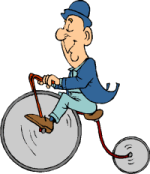More about the Past Tense
Voice
Past Passive So far we have described the past with only one of the two 'voices' - the active. Unlike the active voice, the passive voice does not describe an agent. (Or if it does, it does this by inserting an 'agent clause'.)
Consider the active form-
John took my pen.
'John' is the agent, 'took' is the past simple description of what John did, and 'my pen' is the object which John took.
The past passive of this sentence looks like this -
My pen was taken [by John].
Notice that we do not need the agent clause for the sentence to be complete and grammatical. We can just say 'My pen was taken.' This is also useful if you do not know who took your pen, because you do not need to describe an agent you do not know.
The grammar of the past passive is again the auxiliary 'was/were', but this time the main verb is in the past participle form which we met earlier. Again the positive and negative forms are the same apart from the negative indicator.
My pen was not taken.
Other Aspects of the Passive The passive can be used with all aspects of the past, with auxiliaries used to tell us things like voice and which aspect is being used. This can lead to some complicated and clumsy sentences if done with poor style.
Consider -
The car had been being driven without oil for an hour before they noticed.
When we look at this sentence we can tell from the auxiliaries that the main verb is a past perfect progressive passive. Firstly, the main part of the verb is a past participle, which tells us that the verb is passive with the auxiliary 'be'. We know that the perfect is being used because of the auxiliary 'have' and we know that the verb is progressive because there is an auxiliary 'be' in the continuous form of 'being'. We know that the verb is past perfect, because the past perfect is formed from 'have' and the past participle, and because the main verb is being used to indicate a passive, the past participle is used on the next auxiliary, giving us 'had been'.
Fortunately for English students, such complex constructions are rarely used.
Mood
Yes, sentences have moods – actually they have quite a few moods. For example, a sentence can be inquiring (interrogative mood) as in
What did you think you were doing?
Here the auxiliary 'do' is inverted with the subject 'you' to show that we have a question, and 'do' is in the past to show that the question is past simple. (The second clause is a basic past progressive.)
In modern English we usually use the past subjunctive mood for imaginary situations, or situations that did not happen.
Consider -
If you had told me, I would have helped.(But you did not tell me so I did not help.)
These constructions are called 'conditionals' and you can find out more about them here: https://www.english-online.org.uk/adv7/adv1_7.htm
We also use mood to look at things that did not happen in the past.
He should have remembered my birthday.
I could have been a brain surgeon.
He might have died when he was young.
Some moods are not used in the past – for example the imperative mood (giving orders) is only useful for the present or the future. You cannot tell someone to do something yesterday.
The Intermediate section on the Past Tense Here has more information which you might find useful.

